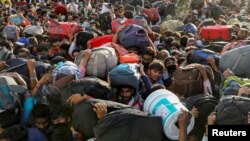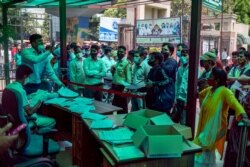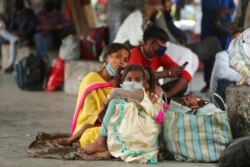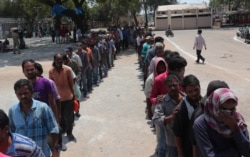For a second time since the COVID-19 pandemic began, rural migrants in India are packing buses and trains to head back to their villages as cities such as Delhi and Mumbai reimpose restrictions to control an unprecedented surge in infections.
Just months ago, millions of migrant workers had returned from their villages to pick up work in factories, restaurants and markets that had begun humming again after a stringent nationwide lockdown imposed in March of last year.
Once again, though, they have been hit with widespread job losses amid the new round of curbs in cities as India reels under a second wave of the pandemic.
After returning to New Delhi in November from his village in India’s northern Uttar Pradesh state, Ashish Kumar found a job at a garment export factory, but he was laid off last month as his company did not get sufficient orders. His hopes of finding other employment receded as businesses slumped again amid a massive surge in infections.
Fearful of a strict lockdown that had abruptly shut off transport and forced migrants to walk hundreds of kilometers home or stay shut in, in tiny city tenements last year, Kumar took no chances. Last week, he returned to his village.
“I could not risk what happened last time. I was stranded in Delhi for two months and had to take out a 25,000 rupee [about $350] loan to buy food and pay rent,” a dispirited Kumar said. “I had barely repaid half of it when I lost my job again.”
“There is no way to make a living in the village, but at least I don’t have to pay rent,” he said.
In recent days, daily infections in India have gone past the 200,000 mark — the highest in the world and more than double the numbers counted at the peak of the first wave last September. On Sunday, the health ministry reported 261,394 cases, a record for a spike in a day. Cities such as Delhi and Mumbai, home to millions of rural migrants, are the worst-hit.
The pendulum has swung completely since the start of the year, when plummeting cases triggered optimism the pandemic had waned in India and hopes rose that the economy, battered by a long lockdown, was getting back on its feet. Its megacities wore a look of normalcy as customers flocked to malls and restaurants, people packed holiday destinations and businesses saw a revival.
Those cities have now again fallen quiet. Delhi has imposed a night and weekend curfew through the end of the month. Mumbai has closed down most industries and markets, and halted construction activity.
Poonam Singh, who spoke with VOA last year after he was stranded in Mumbai, rushed to take a bus to his village in northern Rajasthan state 10 days ago after authorities began warning of strict measures to control soaring infections. He had returned from his rural home three months ago to work at a diamond processing unit. A train ride would have been cheaper, but he could not get a ticket amid the rush by migrants’ home.
“I was worried when talk of a lockdown started. Last time we had to pay 30,000 rupees to a taxi to bring five others and me and five others back,” said Singh, who spent six weeks in a tiny room with three others with little money to buy food.
About 100 million rural migrants work in India’s populous cities in the country’s vast informal sector.
“The past year has been an unprecedented ordeal in the history of migrant labor. Work was not easily available or the number of working days each worker managed to get reduced, so earnings dropped. That has been the perpetual issue since COVID hit,” according to Anhad Imaan, at Aajeevika Bureau, a nonprofit that works with migrant labor in three Western cities — Mumbai, Surat and Ahmedabad, whose thriving industries have long been a magnet for migrant workers from poorer states in the north.
Imaan said his organization doesn’t, know the scale of the exodus yet, but migrants face a tough choice with the pandemic’s resurgence.
“If they go back, there is nothing in the villages. If they stay, they don’t know what is going to close, for how long and how it will impact their work,” he said.
The number of poor people in India or those living on less than $2 a day is estimated to have increased by 75 million because of the COVID-19 recession, according to a recent analysis by Pew Research Center. That accounts for almost 60% of the global increase in poverty, according to the study.
Raghav Malhotra of Aajeevika Bureau, who works among migrants employed by small manufacturers in Mumbai said distress is widespread.
“A lot of people were just about recovering from last year when the restrictions began shutting down businesses again,” he said. “Even those who have stayed back in cities and not returned to their villages are languishing without any work.”
He said government relief measures for the poor remain a severe problem for migrants.
“These cater to domicile workers. Those who don’t have identity papers in the city cannot take advantage of subsidized food announced by the local authorities,” Malhotra said.
The economic hardship is being exacerbated by fears that the migrants could carry the virus to their rural homes, where a creaky health infrastructure is not equipped to cope with the pandemic.













